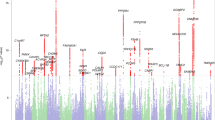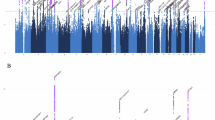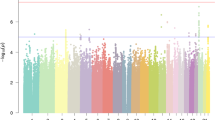Abstract
Dyslexia is one of the most common childhood disorders with a prevalence of around 5–10% in school-age children. Although an important genetic component is known to have a role in the aetiology of dyslexia, we are far from understanding the molecular mechanisms leading to the disorder. Several candidate genes have been implicated in dyslexia, including DYX1C1, DCDC2, KIAA0319, and the MRPL19/C2ORF3 locus, each with reports of both positive and no replications. We generated a European cross-linguistic sample of school-age children – the NeuroDys cohort – that includes more than 900 individuals with dyslexia, sampled with homogenous inclusion criteria across eight European countries, and a comparable number of controls. Here, we describe association analysis of the dyslexia candidate genes/locus in the NeuroDys cohort. We performed both case–control and quantitative association analyses of single markers and haplotypes previously reported to be dyslexia-associated. Although we observed association signals in samples from single countries, we did not find any marker or haplotype that was significantly associated with either case–control status or quantitative measurements of word-reading or spelling in the meta-analysis of all eight countries combined. Like in other neurocognitive disorders, our findings underline the need for larger sample sizes to validate possibly weak genetic effects.
Similar content being viewed by others
Log in or create a free account to read this content
Gain free access to this article, as well as selected content from this journal and more on nature.com
or
References
Katusic SK, Colligan RC, Barbaresi WJ, Schaid DJ, Jacobsen SJ : Incidence of reading disability in a population-based birth cohort, 1976-1982, Rochester, Minn. Mayo Clin Proc 2001; 76: 1081–1092.
Shaywitz SE, Shaywitz BA, Fletcher JM, Escobar MD : Prevalence of reading disability in boys and girls. Results of the Connecticut Longitudinal Study. JAMA 1990; 264: 998–1002.
Shaywitz SE, Fletcher JM, Holahan JM et al: Persistence of dyslexia: the Connecticut Longitudinal Study at adolescence. Pediatrics 1999; 104: 1351–1359.
ICD-10-GM Version 2008: Internationale statistische Klassifikation der Krankheiten und verwandter Gesundheitsprobleme, 10; Revision - German Modification -; Kapitel V: 192.
American Psychiatric Association: Diagnostic and Statistical Manual of Mental Disorders. Washington, DC: American Psychiatric Association, 2000 4th edn. Text Revision, pp 51-52.
Fisher SE, DeFries JC : Developmental dyslexia: genetic dissection of a complex cognitive trait. Nat Rev Neurosci 2002; 3: 767–780.
Barry JG, Yasin I, Bishop DV : Heritable risk factors associated with language impairments. Genes Brain Behav 2007; 6: 66–76.
Williams J, O'Donovan MC : The genetics of developmental dyslexia. Eur J Hum Genet 2006; 14: 681–689.
Schumacher J, Hoffmann P, Schmal C, Schulte-Körne G, Nöthen MM : Genetics of dyslexia: the evolving landscape. J Med Genet 2007; 44: 289–297.
Scerri TS, Schulte-Körne G : Genetics of developmental dyslexia. Eur Child Adolesc Psychiatry 2009; 19: 179–197.
Taipale M, Kaminen N, Nopola-Hemmi J et al: A candidate gene for developmental dyslexia encodes a nuclear tetratricopeptide repeat domain protein dynamically regulated in brain. Proc Natl Acad Sci USA 2003; 100: 11553–11558.
Marino C, Citterio A, Giorda R et al: Association of short-term memory with a variant within DYX1C1 in developmental dyslexia. Genes Brain Behav 2007; 6: 640–646.
Scerri TS, Fisher SE, Francks C et al: Putative functional alleles of DYX1C1 are not associated with dyslexia susceptibility in a large sample of sibling pairs from the UK. J Med Genet 2004; 41: 853–857.
Wigg KG, Couto JM, Feng Y et al: Support for EKN1 as the susceptibility locus for dyslexia on 15q21. Mol Psychiatry 2004; 9: 1111–1121.
Bates TC, Lind PA, Luciano M, Montgomery GW, Martin NG, Wright MJ : Dyslexia and DYX1C1: deficits in reading and spelling associated with a missense mutation. Mol Psychiatry 2009; 15: 1190–1196.
Dahdouh F, Anthoni H, Tapia-Paez I et al: Further evidence for DYX1C1 as a susceptibility factor for dyslexia. Psychiatr Genet 2009; 19: 59–63.
Tapia-Páez I, Tammimies K, Massinen S, Roy AL, Kere J : The complex of TFII-I, PARP1, and SFPQ proteins regulates the DYX1C1 gene implicated in neuronal migration and dyslexia. FASEB J 2008; 22: 3001–3009.
Meng H, Smith SD, Hager K et al: DCDC2 is associated with reading disability and modulates neuronal development in the brain. Proc Natl Acad Sci USA 2005; 102: 17053–17058.
Schumacher J, Anthoni H, Dahdouh F et al: Strong genetic evidence of DCDC2 as a susceptibility gene for dyslexia. Am J Hum Genet 2006; 78: 52–62.
Deffenbacher KE, Kenyon JB, Hoover DM et al: Refinement of the 6p21.3 quantitative trait locus influencing dyslexia: linkage and association analyses. Hum Genet 2004; 115: 128–138.
Francks C, Paracchini S, Smith SD et al: A 77-kilobase region of chromosome 6p22.2 is associated with dyslexia in families from the United Kingdom and from the United States. Am J Hum Genet 2004; 75: 1046–1058.
Cope N, Harold D, Hill G et al: Strong evidence that KIAA0319 on chromosome 6p is a susceptibility gene for developmental dyslexia. Am J Hum Genet 2005; 76: 581–591.
Lind PA, Luciano M, Wright MJ, Montgomery GW, Martin NG, Bates TC : Dyslexia and DCDC2: normal variation in reading and spelling is associated with DCDC2 polymorphisms in an Australian population sample. Eur J Hum Genet 2010; 18: 668–673.
Newbury DF, Paracchini S, Scerri TS et al: Investigation of dyslexia and SLI risk variants in reading and language-impaired subjects. Behav Genet 2011; 41: 90–104.
Ludwig KU, Schumacher J, Schulte-Körne G et al: Investigation of the DCDC2 intron 2 deletion/compound short tandem repeat polymorphism in a large German dyslexia sample. Psychiatr Genet 2008; 18: 310–312.
Wilcke A, Weissfuss J, Kirsten H, Wolfram G, Boltze J, Ahnert P : The role of gene DCDC2 in German dyslexics. Ann Dyslexia 2009; 59: 1–11.
Scerri TS, Morris AP, Buckingham LL et al: DCDC2, KIAA0319 and CMIP are associated with reading-related traits. Biol Psychiatry 2011; 70: 237–245.
Paracchini S, Steer CD, Buckingham LL et al: Association of the KIAA0319 dyslexia susceptibility gene with reading skills in the general population. Am J Psychiatry 2008; 165: 1576–1584.
Luciano M, Lind PA, Duffy DL et al: A haplotype spanning KIAA0319 and TTRAP is associated with normal variation in reading and spelling ability. Biol Psychiatry 2007; 62: 811–817.
Dennis MY, Paracchini S, Scerri TS et al: A common variant associated with dyslexia reduces expression of the KIAA0319 gene. PLoS Genet 2009; 5: e1000436.
Harold D, Paracchini S, Scerri T et al: Further evidence that the KIAA0319 gene confers susceptibility to developmental dyslexia. Mol Psychiatry 2006; 11: 1061.
Paracchini S, Thomas A, Castro S et al: The chromosome 6p22 haplotype associated with dyslexia reduces the expression of KIAA0319, a novel gene involved in neuronal migration. Hum Mol Genet 2006; 15: 1659–1666.
Ludwig KU, Roeske D, Schumacher J et al: Investigation of interaction between DCDC2 and KIAA0319 in a large German dyslexia sample. J Neural Transm 2008; 115: 1587–1589.
Darki F, Peyrard-Janvid M, Matsson H, Kere J, Klingberg T : Three dyslexia susceptibility genes, DYX1C1, DCDC2, and KIAA0319, affect temporo-parietal white matter structure. Biol Psychiatry 2012; 72: 671–676.
Anthoni H, Zucchelli M, Matsson H et al: A locus on 2p12 containing the co-regulated MRPL19 and C2ORF3 genes is associated to dyslexia. Hum Mol Genet 2007; 16: 667–677.
Scerri TS, Darki F, Newbury DF et al: The dyslexia candidate locus on 2p12 is associated with general cognitive ability and white matter structure. PLoS One 2012; 7: e50321.
Paracchini S, Scerri T, Monaco AP : The genetic lexicon of dyslexia. Annu Rev Genomics Hum Genet 2007; 8: 57–79.
Skiba T, Landi N, Wagner R, Grigorenko EL : In search of the perfect phenotype: an analysis of linkage and association studies of reading and reading-related processes. Behav Genet 2011; 41: 6–30.
Landerl K, Ramus F, Moll K et al: Predictors of developmental dyslexia in European orthographies with varying complexity. J Child Psychol Psychiatry 2013; 54: 686–694.
Wechsler D : Wechsler Intelligence Scale for Children 4th edn 2003.
Achenbach T Child Behavior Check-List 2001.
Conners CK : Rating scales for use in drug studies with children. Psychopharmacol Bull 1973; 9: 24–84.
Lao O, Lu TT, Nothnagel M et al: Correlation between genetic and geographic structure in Europe. Curr Biol 2008; 18: 1241–1248.
Novembre J, Johnson T, Bryc K et al: Genes mirror geography within Europe. Nature 2008; 456: 98–101.
Nelis M, Esko T, Magi R et al: Genetic structure of Europeans: a view from the North-East. PLoS One 2009; 4: e5472.
Salmela E, Lappalainen T, Fransson I et al: Genome-wide analysis of single nucleotide polymorphisms uncovers population structure in Northern Europe. PLoS One 2008; 3: e3519.
Schulte-Körne G, Ziegler A, Deimel W et al: Interrelationship and familiality of dyslexia related quantitative measures. Ann Hum Genet 2007; 71: 160–175.
Ripke S, Sanders AR, Kendler KS et al: Genome-wide association study identifies five new schizophrenia loci. Nat Genet 2011; 43: 969–976.
C4D Genetics Consortium: A genome-wide association study in Europeans and South Asians identifies five new loci for coronary artery disease. Nat Genet 2011; 43: 339–344.
Acknowledgements
We are grateful to all the participants that took part in the study as well as all psychologists who recruited and tested those participants. The NeuroDys Consortium was funded by the EU [Neurodys, 018696]. The work conducted at the WTCHG was supported by Wellcome Trust grants [076566/Z/05/Z] and [075491/Z/04]; the work in Zurich partly by an SNSF grant [32-108130]. We also thank MAF (Mutation Analysis core Facility) at the Karolinska Institute, Novum, Huddinge. The French part of the project was funded by Agence Nationale de la Recherche (ANR-06-NEURO-019-01 GENEDYS) and Ville de Paris. S Paracchini is a Royal Society University Research Fellow. D Czamara was supported by the Deutsche Forschungsgemeinschaft (German Research Foundation) within the framework of the Munich Cluster for Systems Neurology (EXC 1010 SyNergy).
Author information
Authors and Affiliations
Corresponding author
Ethics declarations
Competing interests
The authors declare no conflict of interest.
Additional information
Supplementary Information accompanies this paper on European Journal of Human Genetics website
Supplementary information
Rights and permissions
About this article
Cite this article
Becker, J., Czamara, D., Scerri, T. et al. Genetic analysis of dyslexia candidate genes in the European cross-linguistic NeuroDys cohort. Eur J Hum Genet 22, 675–680 (2014). https://doi.org/10.1038/ejhg.2013.199
Received:
Revised:
Accepted:
Published:
Issue date:
DOI: https://doi.org/10.1038/ejhg.2013.199
Keywords
This article is cited by
-
Cumulative genetic score of KIAA0319 affects reading ability in Chinese children: moderation by parental education and mediation by rapid automatized naming
Behavioral and Brain Functions (2023)
-
A comprehensive review of machine learning approaches for dyslexia diagnosis
Multimedia Tools and Applications (2023)
-
Contributions of common genetic variants to specific languages and to when a language is learned
Scientific Reports (2022)
-
Reading and reading-related skills in adults with dyslexia from different orthographic systems: a review and meta-analysis
Annals of Dyslexia (2020)
-
Genome-wide association scan identifies new variants associated with a cognitive predictor of dyslexia
Translational Psychiatry (2019)



